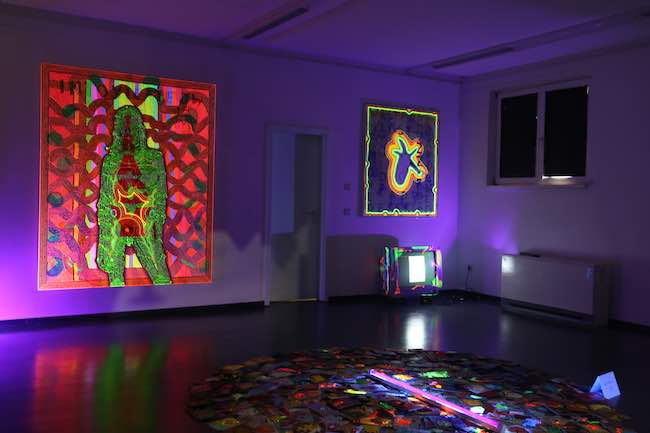Molto spesso l’artista contemporaneo si trova a dover fare i conti con un’esistenza complessa, con sentimenti ed emozioni che sembrano dover essere messi in secondo piano rispetto all’urgenza del vivere, quasi come se egli stesso debba porsi come mezzo per oltrepassare quella distanza trovando un linguaggio che, pur partendo proprio dalle inquietudini e dagli ostacoli, ne esplori le implicazioni oppure indichi una strada per uscirne. Eppure esistono realtà differenti da quella occidentale, popoli che ancora oggi riescono a vivere basandosi sugli insegnamenti del passato non dimenticando l’importanza della semplicità, dell’immediatezza e della capacità di apprezzare la bellezza e la piacevolezza del vivere senza porsi troppe domande, senza galleggiare nei problemi spesso frutto solo della mente dell’uomo stesso. L’artista di cui vi racconterò oggi sceglie un linguaggio antico, tribale, per narrare un mondo semplice ma al passo con i tempi in virtù dell’utilizzo di un particolare tipo di pittura.
L’arte tribale antica ha cominciato ad attrarre l’interesse degli appassionati d’arte durante i primi decenni del Novecento, quando cioè le scoperte tecniche e tecnologiche accorciarono notevolmente i tempi di percorrenza verso paesi più o meno lontani; questo interesse non poteva non essere colto anche dagli artisti che si lasciarono affascinare da quell’immediatezza e spontaneità espressiva che mancava nelle complesse tecniche esecutive del secolo precedente, quelle così orientate all’estetica e alla vicinanza alla realtà osservata da dimenticare il contatto con l’anima, con l’essenza. Malgrado l’interesse prevalente di grandi maestri come Pablo Picasso e Amedeo Modigliani fosse rivolto verso l’Africa, le sue maschere e la loro semplificazione stilistica, vi furono altri tipi di arte primitiva che non vennero esplorate a causa della lontananza geografica che impedì ai creativi di entrare in contatto con le culture artistiche di continenti come l’Australia e le Americhe; l’unico che si spinse fino alla Polinesia, e se ne innamorò al punto di scegliere di vivere lì per sempre, fu Paul Gauguin che però si dedicò a raccontare la vita in quei luoghi osservandoli dal punto di vista colonialista, ammirandone la spontaneità ma non assorbendone lo stile espressivo originario e più antico. Eppure soprattutto nella remota Australia l’arte era parte integrante della cultura aborigena, veniva usata per lasciare messaggi e insegnamenti al popolo e presentava quelle caratteristiche di immediatezza espressiva necessaria a semplificare l’immagine, a dare un senso netto e incisivo a chi doveva osservarla mentre per l’esecutore ciascun dettaglio nascondeva un profondo significato. Gli stili principali dell’arte aborigena erano, e sono tutt’oggi, tre, la pittura a Raggi X in cui le persone o gli animali sono rappresentati sotto forma di scheletri, la Dot Art, in cui i puntini estremamente vicini vanno a formare immagini astratte ma di cui ciascuna parte ha un senso ben preciso oppure effigiano figure fondamentali per la cultura australiana come il canguro, e infine la pittura a stencil associata alla tecnica a spruzzo poi ripresa e ampiamente diffusa grazie alla Street Art. L’artista tedesco Alfred Müller si avvicina all’arte tribale aborigena nello stile espressivo e anche per la tecnica della riproduzione delle immagini simbolo della vita semplice a cui aspira, ma si distacca dalla Dot Art trasformandola in Line Art, più vicina alle linee quasi labirintiche tipiche della pittura di Keith Haring pur modificandone la rappresentazione.
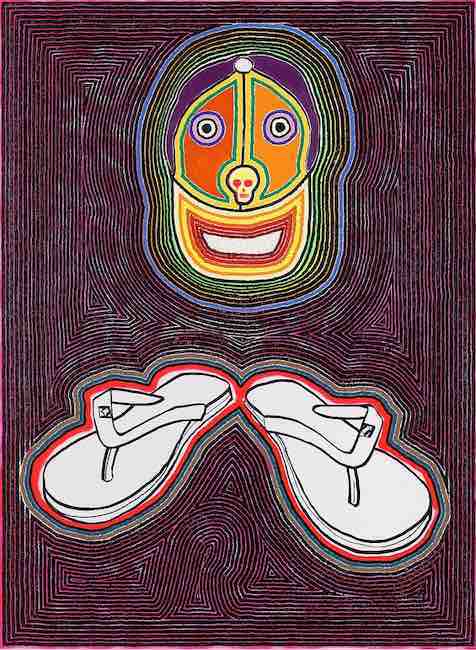
In Müller infatti quelle stesse linee sono continue e quasi ipnotiche, realizzate con pittura al neon, e divengono sfondi su cui le figure protagoniste emergono e vengono esaltate mentre in altre opere diventano addirittura dettagli dell’interno dei personaggi, quelli realizzati a volte con la tecnica a Raggi X rivisitata, altre stilizzando il soggetto su cui agisce con la pittura a spray.

Nella serie di lavori più recenti, denominata Las Coloradas, si è lasciato ispirare dalla cultura messicana dello Yucatan, dove si reca molto spesso, che involontariamente e senza averlo meditato lo ha portato a spostarsi dalla monocromia delle sue opere precedenti color argento a un’esplosione di colori, perché osservare gli arazzi realizzati con un arcobaleno di fili variopinti e respirare l’atmosfera vivace e al tempo stesso tranquilla di quella regione del Messico lo ha indotto a comprendere il potere benefico della moltitudine di tonalità e di rilievi che proprio in virtù dell’accostamento di tonalità differenti si manifesta.
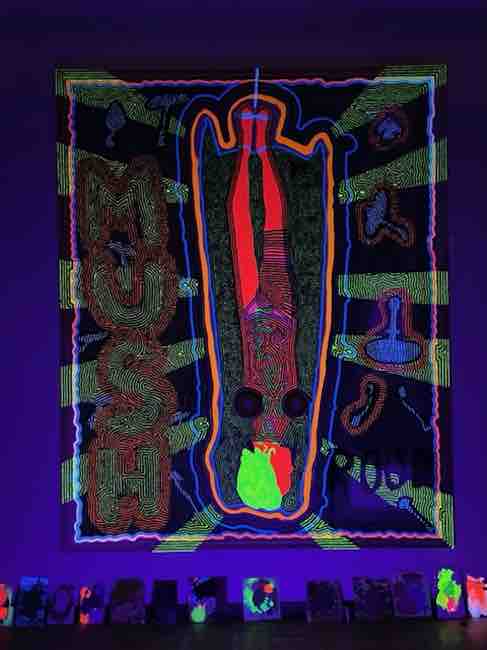
Ma l’attitudine sperimentatrice dell’artista non riesce a non tendere verso la ricerca dell’unicità che si manifesta con la caratteristica di accendere letteralmente le opere attraverso quella pittura al neon che si illumina al buio dando nuova veste all’opera, quasi come se l’oscurità permettesse di osservare un aspetto abitualmente nascosto con la luce del sole, esattamente come avviene nella realtà. Dunque il volto delle sue opere si modifica tendendo verso un’Op Art non più intesa come inganno dello sguardo calamitato verso un apparente movimento bensì trasformata in un mondo sotterraneo e diverso che si svela agli occhi nell’ombra, ma anche nella penombra in cui il colore base lascia fuoriuscire il neon creando un cangiante movimento, e che subito dopo ritorna al suo aspetto originario, quello visibile nella luminosità.
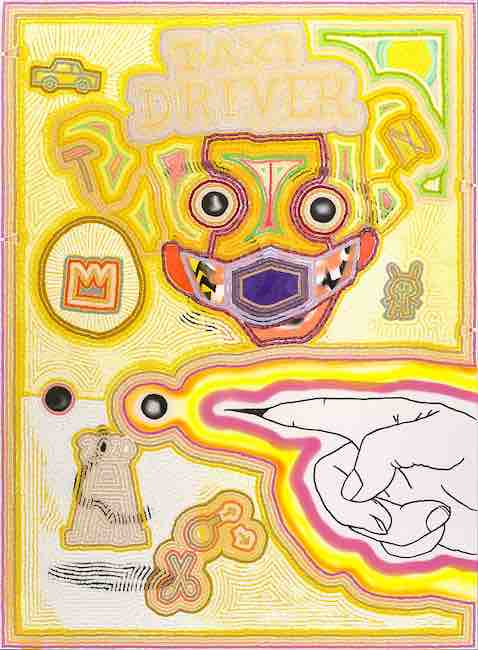
Alfred Müller mostra anche un lato ironico, dissacrante e divertente soprattutto quando inserisce nell’opera delle mani che sembrano invadere lo spazio del personaggio, a volte disturbandolo altre invece interagendo con esso, come a invitare l’osservatore a giocare di più, a prendersi in giro perché in fondo la semplicità della vita si raggiunge anche attraverso l’autoironia; o come quando racconta la donna rendendola quasi impalpabile, semplificandone pertanto quelle complicazioni che forse, suggerisce l’artista, esistono solo a causa dell’incapacità dell’uomo di comprenderla davvero.
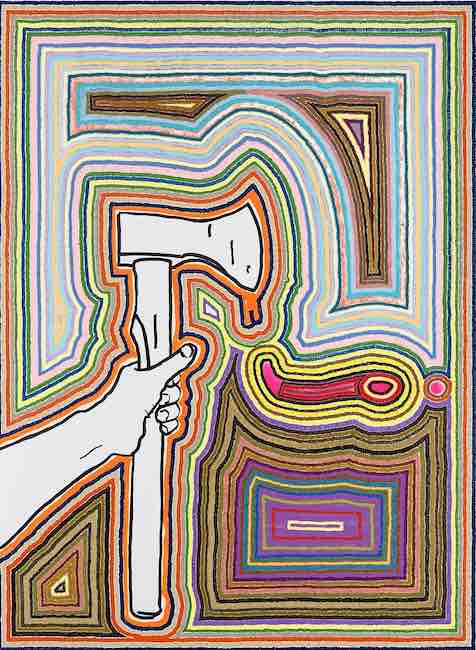
Nell’opera Hacha maldita (Ascia maledetta) Müller sembra voler riprodurre un simbolo di lotta, di aggressività, sdrammatizzandolo, stilizzandolo e circondandolo di un’aura chiara, come se l’energia positiva della gamma cromatica tenue la rendesse meno minacciosa. Le linee amplificano l’immagine principale e rendono quasi ipnotica la tela, come se il soggetto principale dovesse emergere catturando lo sguardo per poi perdersi nello sfondo che sembra un’eco del movimento che sta per compiersi.

In Flamenco (Fenicottero) emerge invece la poesia magica di un uccello che suscita serenità, armonia, equilibrio e che con la sua presenza immobile è in grado di affascinare lo sguardo anche per la capacità di restare in piedi, spesso su una sola gamba, malgrado il corpo sia apparentemente molto più pesante delle lunghe e sottili zampe. Sembra quasi una metafora dell’essere umano quella raccontata da Müller, di quella ricerca di un bilanciamento tra passato e presente, tra il peso che ciascuno porta con sé e che spesso costituisce la sua stessa essenza e patrimonio emozionale, e l’instabilità del presente e del futuro in cui tuttavia riesce a trovare un modo per resistere e andare avanti. Le linee sono ancor più catalizzatrici in questa opera, perché emanano quella sottile fascinazione a cui lo sguardo non riesce a sottrarsi e che diverrà ancor più intensa spegnendo le luci, con il buio, perché a quel punto i colori fluo esalteranno l’essenza dell’animale tanto quanto quello dello sfondo che lo circonda e grazie al quale viene messo in evidenza.

In Lily (Lillà) emergono i disegni tipici degli arazzi messicani, svelando tutto l’amore di Müller per quella cultura in cui ormai da anni si sente a casa, in cui riesce a ritrovare se stesso grazie alla semplicità e alla calma che contraddistingue il popolo yucateco, di origini Maya, e che si riflette non solo nella vita quotidiana ma anche nell’artigianato locale, nei colori, nell’immediatezza dei disegni dei tappeti e dei lavori di filatura. In questo dipinto il fiore, nella sua disarmante bellezza, è contornato di segni geometrici, quelli appunto che caratterizzano gli arazzi messicani e le linee concentriche sembrano lasciare spazio alla natura, come se la delicatezza avesse bisogno di maggiore aria per emergere e respirare; tanto quanto l’essere umano, sembra suggerire l’artista, ha bisogno di soffermarsi un attimo in più per avere la capacità di ritrovare quel contatto primordiale e immersivo nella natura spesso dimenticata nella cultura occidentale. Alfred Müller ha alle spalle un lungo percorso artistico e di studio, è stato allievo di Georg Baseliz, e la sua arte è riconosciuta in tutto il mondo per l’unicità che la contraddistingue; recentemente ha avviato proprio in Messico una produzione di foulards e parei con le stampe delle sue opere, introducendo dunque il suo mondo di colori anche nella moda.
ALFRED MÜLLER-CONTATTI
Email: info@am-art.de
Sito web: http://mueller-alfred.com/
Facebook: https://www.facebook.com/alfred.muller.1420354
Instagram: https://www.instagram.com/alfredmuellerartist/
The psychedelic art by Alfred Müller, between tribal painting and neon colours to emphasise the mutability of reality
Very often the contemporary artist finds himself having to come to terms with a complex existence, with feelings and emotions that seem to have to take second place to the urgency of living, almost as if he himself has to place as a means of overcoming that distance by finding a language that, while starting from the very anxieties and obstacles, explores their implications or points a way out of them. Yet there are realities that are different from those of the West, peoples who still manage to live based on the teachings of the past without forgetting the importance of simplicity, immediacy and the ability to appreciate the beauty and pleasantness of living without asking too many questions, without floating around in problems that are often only the result of man’s own mind. The artist I am going to tell you about today chooses an ancient, tribal language to narrate a world that is simple but in step with the times by virtue of the use of a particular type of painting.
Ancient tribal art began to attract the interest of art enthusiasts during the first decades of the 20th century, when technical and technological discoveries considerably shortened travel times to more or less distant countries; this interest could not fail to be grasped by artists who allowed themselves to be fascinated by that immediacy and spontaneity of expression that was lacking in the complex techniques of the previous century, those so oriented towards aesthetics and closeness to the observed reality as to forget contact with the soul, with the essence. Although the prevailing interest of great masters such as Pablo Picasso and Amedeo Modigliani was directed towards Africa, its masks and their stylistic simplification, there were other types of primitive art that were not explored due to the geographical remoteness that prevented creative artists from coming into contact with the artistic cultures of continents such as Australia and the Americas; the only one who went as far as Polynesia, and fell in love with it to the point of choosing to live there forever, was Paul Gauguin who, however, devoted himself to depicting life there by observing it from a colonialist point of view, admiring its spontaneity but not absorbing its original and older style of expression.
Yet especially in remote Australia, art was an integral part of Aboriginal culture, it was used to leave messages and teachings to the people and had those characteristics of expressive immediacy necessary to simplify the image, to give a clear and incisive sense to those who had to observe it, while for the author each detail concealed a profound meaning. The main styles of Aboriginal art were, and still are, three, X-ray painting in which people or animals are represented as skeletons, Dot Art, in which extremely close dots form abstract images but in which each part has a precise meaning or portrays figures fundamental to Australian culture such as the kangaroo, and finally stencil painting associated with the spray technique later revived and widely diffused thanks to Street Art. The German artist Alfred Müller comes close to Aboriginal tribal art in his expressive style and also in the technique of reproducing the images that symbolise the simple life to which he aspires, but he distances himself from Dot Art by transforming it into Line Art, closer to the almost labyrinthine lines typical of Keith Haring’s painting, although modifying its representation.
In fact, in Müller, those same lines are continuous and almost hypnotic, created with neon paint, and become backgrounds on which the protagonist figures emerge and are enhanced, while in other artworks they even become details of the characters’ interiors, those realised sometimes with the revisited X-ray technique, others by stylising the subject on which he acts with spray paint. In the series of more recent works, called Las Coloradas, he was inspired by the Mexican culture of the Yucatan, where he goes very often, which involuntarily and without having meditated on it led him to move from the monochrome of his previous silver-colored artworks to an explosion of colors, because observing the tapestries made with a rainbow of multicolored threads and breathing the lively and at the same time peaceful atmosphere of that region of Mexico led him to understand the beneficial power of the multitude of tones and reliefs that, precisely by virtue of the combination of different shades manifests itself. But the artist’s experimental attitude cannot fail to tend towards the search for uniqueness, which manifests itself in the characteristic of literally illumintating the artworks through that neon paint that lights up in the dark, giving the work a new look, almost as if the darkness allowed one to observe an aspect that is usually hidden by sunlight, just as it happens in reality. Thus, the face of his paintings changes, tending towards an Op Art no longer intended as deception of the gaze drawn towards an apparent movement, but transformed into a different, subterranean world that reveals itself to the eyes in the shadows, but also in the half-light in which the basic colour allows the neon to escape, creating an iridescent movement, and which immediately returns to its original appearance, that which is visible in the brightness.
Alfred Müller also shows an ironic, desecrating and amusing side, especially when he inserts in the artworks hands that seem to invade the character’s space, sometimes disturbing him, sometimes interacting with him, as if to invite the observer to play more, to make fun of himself, because after all, the simplicity of life can also be achieved through self-irony; or when he tells the story of the woman by making her almost impalpable, thus simplifying those complications that perhaps, the artist suggests, only exist because of man’s inability to truly understand her. In the painting Hacha maldita (Cursed Axe), Müller seems to want to reproduce a symbol of struggle, of aggression, downplaying, stylising and surrounding it with a light aura, as if the positive energy of the soft colour range made it less threatening. The lines amplify the main image and make the canvas almost hypnotic, as if the main subject should emerge catching the eye and then get lost in the background which seems to echo the movement that is about to take place. In Flamingo, on the other hand, emerges the magical poetry of a bird that arouses serenity, harmony, balance and that with its motionless presence is able to captivate the gaze also because of its ability to remain standing, often on a single leg, despite the fact that its body is apparently much heavier than its long, thin legs. It almost seems like a metaphor of the human being that told by Müller, of that search for a balance between past and present, between the weight that each person carries and which often constitutes their very essence and emotional heritage, and the instability of the present and future in which they nevertheless manage to find a way to resist and move forward.
The lines are even more catalysing in this painting, because they emanate that subtle fascination from which the eye cannot escape and which will become even more intense when the lights are switched off, with the darkness, because at that point the fluorescent colours will enhance the essence of the animal as much as that of the background that surrounds it and thanks to which it is highlighted. In Lily, the typical designs of Mexican tapestries emerge, revealing all Müller’s love for that culture in which he has felt at home for years, in which he has been able to find himself again thanks to the simplicity and calmness that characterises the Yucateco people, of Mayan origin, and which is reflected not only in daily life but also in the local craftsmanship, the colours, the immediacy of the designs of the carpets and the spinning work. In this painting, the flower, in its disarming beauty, is surrounded by geometric signs, those that characterise Mexican tapestries, and the concentric lines seem to leave room for nature, as if the delicacy needed more air to emerge and breathe; as much as the human being, the artist seems to suggest, needs to pause a moment longer to have the ability to rediscover that primordial and immersive contact with nature often forgotten in western culture. Alfred Müller has a long artistic career and study behind him, he was a student of Georg Baseliz, and his art is recognised over the world for its uniqueness. He has recently started up a production in Mexixo of scarves and sarongs with prints of his works, thus introducing his world of colour into fashion as well.


